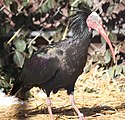Geronticus
| Geronticus[1] | |||
| Wagler, 1832[2] | |||
 Przedstawiciel rodzaju – ibis grzywiasty (G. eremita) | |||
| Systematyka | |||
| Domena | |||
|---|---|---|---|
| Królestwo | |||
| Typ | |||
| Podtyp | |||
| Gromada | |||
| Podgromada | |||
| Infragromada | |||
| Rząd | |||
| Podrząd | |||
| Rodzina | |||
| Rodzaj | Geronticus | ||
| Typ nomenklatoryczny | |||
Tantalus calvus Boddaert, 1783 | |||
| Synonimy | |||
| |||
| Gatunki | |||
| |||
Geronticus – rodzaj ptaka z rodziny ibisów (Threskiornithidae).
Zasięg występowania
Rodzaj obejmuje gatunki występujące w Afryce, dawniej także na Bliskim Wschodzie[4].
Morfologia
Długość ciała 70–80 cm, rozpiętość skrzydeł 125–135 cm; masa ciała samic 1350–1470 g, samców 1540 g[4].
Systematyka
Etymologia
- Geronticus: gr. γεροντικως gerontikōs „jak starzec” (tzn. łysy), od γερων gerōn, γεροντος gerontos „starzec”[5].
- Comatibis: łac. comatus „włochaty”, od coma „włosy na głowie”, od gr. κομη komē hair; ibis, ibidis „ibis”, od gr. ιβις ibis, ιβιδος ibidos „ibis”[6]. Gatunek typowy: Ibis comatus Ehrenberg, 1825 (= Upupa eremita Linnaeus, 1758).
Podział systematyczny
Do rodzaju należą następujące gatunki[7]:
- Geronticus eremita (Linnaeus, 1758) – ibis grzywiasty
- Geronticus calvus (Boddaert, 1783) – ibis łysy
oraz wymarłe:
- Geronticus perplexus[8] A. Milne-Edwards, 1869
- Geronticus apelex[9] Olson, 1985
- Geronticus balcanicus[10][11] Boev, 1998
Przypisy
- ↑ Geronticus, [w:] Integrated Taxonomic Information System [online] (ang.).
- ↑ J.G. Wagler. Neue Sippen und Gattungen der Säugthiere und Vögel. „Isis von Oken”. 1832, s. 1232, 1832. (niem.).
- ↑ H.G.L. Reichenbach: Avium systema naturale. Das natürliche system der vögel mit hundert tafeln grösstentheils original-abbildungen der bis jetzt entdecken fast zwölfhundert typischen formen. Vorlaüfer einer iconographie der arten der vögel aller welttheile. Dresden und Leipzig: Expedition der vollständigsten naturgeschichte, 1850, s. xiv. (niem.).
- ↑ a b D.W. Winkler, S.M. Billerman & I.J. Lovette: Ibises and Spoonbills (Threskiornithidae), version 1.0. W: S.M. Billerman, B.K. Keeney, P.G. Rodewald & T.S. Schulenberg (red.): Birds of the World. Ithaca, NY: Cornell Lab of Ornithology, 2020. DOI: 10.2173/bow.thresk1.01. [dostęp 2020-05-25]. (ang.).

- ↑ Geronticus, [w:] The Key to Scientific Names, J.A. Jobling (red.), [w:] Birds of the World, S.M. Billerman et al. (red.), Cornell Lab of Ornithology, Ithaca [dostęp 2022-01-31] (ang.).
- ↑ Comatibis, [w:] The Key to Scientific Names, J.A. Jobling (red.), [w:] Birds of the World, S.M. Billerman et al. (red.), Cornell Lab of Ornithology, Ithaca [dostęp 2022-01-31] (ang.).
- ↑ Systematyka i nazwy polskie za: P. Mielczarek & M. Kuziemko: Rodzina: Threskiornithidae Poche, 1904 - ibisy - Ibises (Wersja: 2019-10-12). [w:] Kompletna lista ptaków świata [on-line]. Instytut Nauk o Środowisku Uniwersytetu Jagiellońskiego. [dostęp 2020-02-23].
- ↑ J. Mlíkovský: Cenozoic Birds of the World. Cz. 1: Europe. Praga: Ninox Press, 2002. ISBN 80-901105-3-8.
- ↑ S.L. Olson. Early Pliocene ibises (Aves, Plataleidae) from south-western Cape Province, South Africa. „Annals of the South African Museum”. 97, s. 57–69, 1985. (ang.).
- ↑ Z. Boev. Presence of Bald Ibises (Geronticus Wagler, 1832) (Threskiornithidae - Aves) in the Late Pliocene of Bulgaria. „Geologica Balcanica”. 28, s. 45–52, 1998. (ang.).
- ↑ Z. Boev. Additional Material of Geronticus balcanicus Boev, 1998, and Precision of the Age of the Type Locality. „Acta Zoologica Bulgarica”. 52 (2), s. 53–58, 2000. (ang.).
Media użyte na tej stronie
Autor: (of code) -xfi-, Licencja: CC BY-SA 3.0
The Wikispecies logo created by Zephram Stark based on a concept design by Jeremykemp.
Autor: Ltshears, Licencja: CC BY-SA 3.0
Waldrapp Ibis Geronticus eremita at the Louisville Zoo
Autor: Jakob Voß, influenced by original art designed at PLoS, modified by Wikipedia users Nina and Beao, Licencja: CC0
Closed Access logo, derived from PLoS Open Access logo. Alternative version.


